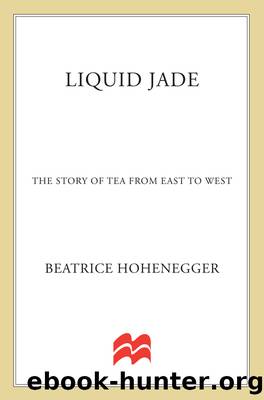Liquid Jade by Beatrice Hohenegger

Author:Beatrice Hohenegger
Language: eng
Format: epub
Publisher: St. Martin's Publishing Group
Tea Tom and Mr. Taylor
They called him sami dorai (the master who is god).
âReferring to James Taylor, the true father of Ceylon tea
Scotsmen seem to be mysteriously attracted to tea. Robert Fortune, the tea spy in China, was a Scotsman. The Bruce brothers in Assam, who were the first to come into contact with the Indian tea plant, were Scotsmen. Now two more Scotsmen landed on the shores of that mesmerizing island, the teardrop of IndiaâSri Lanka, once called Ceylon. They covered its hills with acres and acres of lush, deep-green tea bushes. Within a few decades of their arrival, the word Ceylon would be a synonym for tea, recognized around the world. One Scotsman did the real work; the other raked in the profits. Predictably, history remembers the millionaire, not the genius.
The story of Ceylon tea starts with coffee. The Hemileia vastatrix is not an ancient Roman goddess of war and destruction, but something close to that. Also called coffee rust, H. vastatrix is a devastating fungus that takes the form of an orange powder. It attacks the bottom of coffee leaves and slowly chokes the plants to death by impairing photosynthesis. One of the most feared diseases among coffee growers, it appeared in Ceylon during the 1860s andâmicroscopic in size but relentless in scopeâproceeded to destroy 250,000 acres of coffee plantations over a ten-year period. The coffee rust ruined not only plants but also the livelihoods of countless people involved in coffee plantations, whether pickers or investors, carriers or managers. Many of the Europeans who had come to Ceylon with great hopes were left penniless. A few were able to scrape together enough money for the passage back home. For the ones who stayed behind, the future looked just like their coffee bushes: sterile, dried out, hopeless.
One of the young men who stayed was James Taylor. He was the first Scotsman of our story, the one who did the work. Taylor arrived on the island in 1852 as a boy of sixteen. Encouraged by his cousin, he had left his small village in the Scottish Highlands and signed a three-year contract to work on a coffee plantation. Young James was inquisitive and interested in learning about everything. He worked hard, was persistent, and was good at whatever he did, be it building a road, constructing a bungalow, or solving problems large and small on the plantation. Experimenting was an activity that came naturally to Taylor. He planted some newly arrived China tea seeds along the roadside of the Loolecondera Estate where he was employed.
While H. vastatrix was spreading death and destruction, and people were abandoning the island like rats on a sinking ship, Taylor was busy focusing on a solution. At first he grew cinchona, the plant from which quinine is extracted and which helped the estate through the difficult years. Then he turned his attention to tea. He asked questions wherever he could, investigated soil characteristics, tested pruning techniques, learned how to pluck. In the beginning the
Download
This site does not store any files on its server. We only index and link to content provided by other sites. Please contact the content providers to delete copyright contents if any and email us, we'll remove relevant links or contents immediately.
| Beer | Cocktails & Mixed Drinks |
| Coffee & Tea | Homebrewing, Distilling & Wine Making |
| Juices & Smoothies | Wine & Spirits |
101 Whiskies to Try Before You Die by Ian Buxton(44901)
World's Best Whiskies by Dominic Roskrow(44817)
Whiskies Galore by Ian Buxton(41935)
Craft Beer for the Homebrewer by Michael Agnew(18194)
Right Here, Right Now by Georgia Beers(4166)
Not a Diet Book by James Smith(3373)
Water by Ian Miller(3155)
The Coffee Dictionary by Maxwell Colonna-Dashwood(3094)
Kitchen confidential by Anthony Bourdain(3044)
Coffee for One by KJ Fallon(2598)
Smuggler's Cove: Exotic Cocktails, Rum, and the Cult of Tiki by Martin Cate & Rebecca Cate(2495)
Superfood Smoothie Bowls: Delicious, Satisfying, Protein-Packed Blends that Boost Energy and Burn Fat by Chace Daniella(2418)
Beer is proof God loves us by Charles W. Bamforth(2414)
Talking as Fast as I Can by Lauren Graham(2410)
Bourbon: A Savor the South Cookbook by Kathleen Purvis(2261)
A Short History of Drunkenness by Forsyth Mark(2254)
Eat With Intention by Cassandra Bodzak(2172)
Cocktails for the Holidays by Editors of Imbibe magazine(2097)
Colombia Travel Guide by Lonely Planet(2085)
